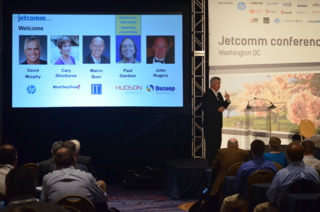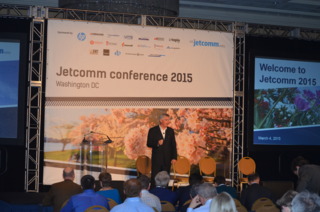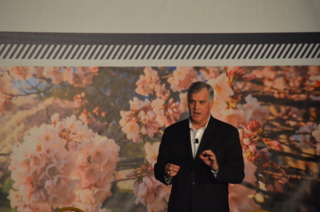Executive Q&A: David Murphy, WW Director of Marketing & Business Development, HP Inkjet High-speed Production Solutions (IHPS)
Inkjet's Age talks with David Murphy, WW Director of Marketing & Business Development, HP Inkjet High-speed Production Solutions (IHPS), about HP, production inkjet, electronic media, and print innovation.

IA: Tell us a little about your company, the segment of the market it serves, and what you consider to be your "core" users.
David Murphy: By October 31, 2015, Hewlett-Packard Company will complete its announced separation into two separate industry-leading Fortune 50 companies. One of the companies, comprising HP's enterprise hardware, software and services businesses, will be known as Hewlett-Packard Enterprise. The other, made up of its PC and printing businesses, will be called HP Inc. HP Inkjet High-speed Production Solutions (IHPS), along with complementary divisions within the fast-growing Graphics Solutions Business (GSB), will become part of the new HP Inc.
The HP IHPS division was launched in 2008 with the introduction of the first high-speed continuous-feed color HP T300 Inkjet Web Press. Since that time, IHPS’ portfolio has expanded to ten inkjet press models across four web-width platforms. Our customers buy HP Inkjet Web Presses to print high quality in high volumes (currently averaging about four billion pages per month in total). Today, HP holds leading market share in total page capacity and in high-end press models. Our core applications are publishing (books, journals, catalogs, magazines), corrugated packaging, production mail (customer communications and promotional mail), and general commercial print. The transactional print market is served by our distribution partner, Pitney Bowes.
IA: How did you get involved with the company? What is your background before that?
DM: I joined HP in 2010 as Americas marketing director for the HP Graphics Solutions Business. After four successful years in that group, I moved to my current role as worldwide marketing director for IHPS. These last five years have been a period of rapid growth and continued innovation for HP inkjet technology and our graphics business overall. Prior to joining HP, I worked for RISO, Inc for 18 years in roles that extended from marketing VP to a range of sales leadership, business development and business management positions. In 2004, I first fell in love with the potential of production inkjet and today I am continually amazed at how far thermal inkjet technology has advanced.
IA: What do you consider your greatest achievement in this market to be?
DM: What I do is a team sport and there are really no individual achievements that one person should claim. From that perspective, I am most proud of the work that our HP high-speed inkjet team is doing right now to bring new innovations to the market. To capture more commercial applications, we are introducing higher image quality and higher speeds through our High-Definition Nozzle Architecture (HDNA) technology. To enable an ever-growing range of standard offset coated media, we are introducing new HP priming solutions. To provide first-to-market inkjet benefits to corrugated packaging converters, we are enabling digital preprint of top liners through our HP T400 and our recently announced T1100 Simplex Color Inkjet Web Presses. We just launched Jetcomm with our customers, which is the industry’s first global user community of high-speed inkjet users. It’s especially gratifying to know that our greatest achievements are ahead of us and we are eager to announce several new innovation proof points in the coming months.
IA: If there was anything you could change, either about your career in regards to the print industry, your company, or the market as a whole, what would it be and why?
DM: I would not change anything about my career in hindsight, as I love what I do and I am proud of the relationships and experiences it has given me. If I could be granted a wish for the market, I would like to see more print providers think more progressively about their futures. There are still too many printers trying to do business as they did in 2007, and they are resistant to risk-taking and change. It’s inspiring to meet a printer who has a vision for the next ten years, who understands the value of inkjet and digital print technologies and who is thinking of how to add unique new value to his/her clients. If there were more printers like that, the market would likely be growing overall.
IA: What do you consider the greatest challenge to be for the industry right now? Why?
DM: Print substitution by electronic media is the greatest challenge. Yet it is becoming increasingly evident that print media will not die but will continue on an accelerated path of offset-to-digital transference. The great opportunities are with print providers who are proactively investing in data management and digital technologies and are thus creating new value through an integrated data-driven media mix. With this strategy, print will profitably remain as the anchor of content that is complemented by other media.
IA: What do you consider the greatest asset to be for the industry right now? Why?
DM: The greatest asset today is the speed of print technology innovation. There are more meaningful advancements in digital print solutions by more suppliers than any time in the last 20 years. With this opportunity comes a risk: with technologies changing so quickly, printers should be careful to make investments that won't be obsolete and that they won't regret in three to five years. To protect their investments, printers should seek to invest with suppliers that will allow them to scale and upgrade their solutions over the next ten years and beyond.
IA: In your opinion, what have been the biggest changes to the way we communicate with one another in the past few years? How would you recommend this industry take advantage of that?
DM: Mobile technology, accompanied by user-driven social platforms, is the greatest driver of change in how content is shared and consumed today. Digitally printed media continues as a relevant and useful channel for this content. We will see increasing integration and cooperation between digital print and electronic media in the near future. Content providers and consumers will be able to benefit from new blended reality platforms, in which printed and electronic content can complement one another.
IA: Looking ahead, what major innovations or technologies do you believe will shape the future of the industry? Why?
DM: Content will be generated, packaged, and delivered to consumers in a timely and customized format based on each user’s preferences and requirements. We will see this in publishing, production mail, and packaging. Digital print will play a critical role in this integration.
IA: What is the biggest piece of advice you would give to printers and others involved in this industry?
DM: Don’t mistakenly believe that the future pace of change and innovation will remain at today’s velocity. It will accelerate ever rapidly. Those who will thrive in the new dynamic environment will be those who are lean and versatile, forward-thinking, constantly learning and are able to act decisively. Those waiting on the sidelines hoping that they can catch up in the future will be left behind.
IA: Is there anything else you would like to share with our readers?
DM: Be confident in the future of inkjet. It is a versatile and scalable technology, and it is only in its nascent stage of development. After just seven years, continuous feed inkjet volume is at the cusp of overtaking electrophotographic (EP) volume. Analog production print will be around for decades, but shrinking run lengths, the proliferation of customized and versioned content and technological improvements will drive ever more volume to inkjet.



